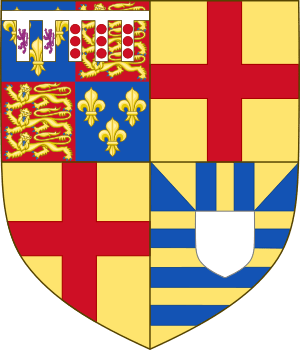Edmund, Earl of Rutland facts for kids
Quick facts for kids Edmund of York |
|
|---|---|
| Earl of Rutland | |
| Born | 17 May 1443 Rouen, Normandy, France |
| Died | 30 December 1460 (aged 17) Wakefield, Yorkshire, England |
| Burial | 30 July 1476 Church of St Mary and All Saints, Fotheringhay, Northamptonshire |
| House | York |
| Father | Richard, 3rd Duke of York |
| Mother | Cecily Neville |
Edmund, Earl of Rutland (born May 17, 1443 – died December 30, 1460) was a young English nobleman. He was the second son of Richard Plantagenet, 3rd Duke of York, and Cecily Neville. His older brother, Edward, later became King Edward IV.
Edmund was born in Rouen, which was then under English control in France. He was given the title of Earl of Rutland by King Henry VI when he was about 11 years old. Sadly, he died at just 17 during the Wars of the Roses, a big fight for the English throne.
Contents
Edmund's Role in Ireland
In 1451, Edmund's father, who was the Lord Lieutenant of Ireland, gave Edmund an important job. He made Edmund the Lord Chancellor of Ireland. This was a very high position in the government.
Deputy Chancellors
Since Edmund was too young to do the job himself, other people acted as his deputies. His first deputy was Edmund Oldhall, who was a bishop. Later, John Talbot, 2nd Earl of Shrewsbury, took over this role.
Irish Parliament's Independence
During Edmund's time as Chancellor, the Parliament of Ireland made a big decision. It said that Ireland had its own laws, separate from England. This meant that people in Ireland only had to follow laws made by the Irish Parliament. They also said that English laws could not be forced on Irish people.
In Ireland, the House of York (Edmund's family side) had strong supporters. These included Thomas FitzGerald, 7th Earl of Kildare, and James FitzGerald, 6th Earl of Desmond. The rival House of Lancaster was mainly supported by James Butler, 5th Earl of Ormonde.
Edmund's Death in Battle
Edmund died at the age of 17 during or right after the Battle of Wakefield on December 30, 1460. This battle was a key moment in the Wars of the Roses. He fought alongside his father in the battle.
The Battle of Wakefield
When the battle started to go badly for his father's side, Edmund tried to escape. He was trying to get away over Wakefield Bridge. However, he was caught and killed. Many people believe he was killed by a Lancastrian noble named Lord Clifford. This was possibly revenge for Clifford's own father's death in an earlier battle.
Some stories say that Edmund's tutor begged Lord Clifford to spare him. But Lord Clifford reportedly said, "Your father killed mine; and so will I do you and all your kin." He then killed Edmund. However, this specific story doesn't appear in the old records from that time.
Edmund's head, along with his father's and uncle's, was put on display on the gates of York. This was a common, but gruesome, practice at the time.
Burial and Legacy
Edmund and his father were first buried at Pontefract Priory. Later, their bodies were moved and reburied with a grand ceremony. This happened at the family tomb in Fotheringhay Castle in 1476. Lord Clifford, who killed Edmund, was himself killed a few months later in another battle.
Arms
 |
|
Images for kids


